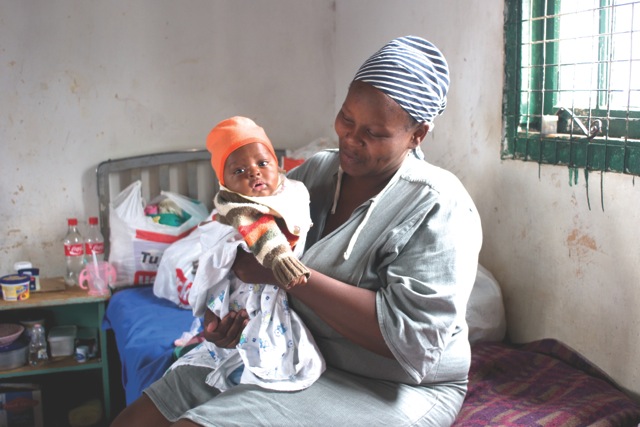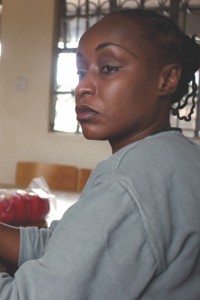
First published in the October 2012 issue of Destination Magazine
There are collectively held preconceived notions about prisons, and they’re not great. The very idea is enough to keep most people from committing crimes. But what is life really like for the women locked up in Lang’ata Prison? By Caitlin Nordahl
Being Rehabilitated
“And what will be the third element?” demands Jaqualine Onyango, one of the officers in charge of teaching the inmates in the prison’s school system. She’s greeted with silence and nervous smiles, but responds harshly with, “I won’t tell you that, I’ll expect you to bring me the answer later. I can’t give you every answer.” But the stern act is belied by a small laugh at the end.
Onyango was a teacher for eight years before coming to Lang’ata in 2012. “The education system in prison,” she says with a chuckle, “is challenging.”
Inmates have to have long enough sentences to participate, otherwise they are released before they really get started. There is, however, the three-month computer class for women who want to learn but aren’t there for long. They also have to be determined fit to go to the school, meaning they have to be disciplined.
Once the women are in the classes though, it’s on them to be good students. “It depends on how committed the students are. If they don’t want to come to class we don’t force them.”
However, she is quick to proudly point out that most of her students – she’s currently teaching a little over 20 women spread throughout different levels – are above average. Another point of pride is that most of the women serving longer sentences are in or have been through the education system.
Elizabeth, with her five-year sentence, is serious about learning. “I’m going back to school because my son needs me more than ever and I don’t want him to ever regret being born,” she explains. “At least he can be proud of his mother, because he doesn’t have a father now. I’m the only one he’s looking up to. And I love my boy so much.”
The industry building is a long, narrow room bustling with activity and oddly dark, considering the intricate work going on. The inmates are arranged according to what they’re doing, with women making sisal baskets in one corner, women doing needlepoint a bit further on, women sewing and tailoring uniforms just next to the women ironing them and women doing beadwork in the back. The finished products are offered up for sale to visitors in the showroom, just inside the gates, as well as at any official prison function and at some local fairs and markets.
While a large chunk of the proceeds goes towards more supplies, the inmates involved in the projects also get a cut – an important source of supplemental income to add to what their families can give them. The particularly industrious can make up to KSH 1,000 in a good month, but KSH 500 isn’t an unheard of sum.

A Difficult Life
Money can be problematic for the inmates, particularly those whose families live far outside Nairobi. Because the prison encompasses capital offenders, women from around the country are held there. Few of their families are able to visit on a regular basis, and when they do they spend a lot of money getting there and can’t leave much more.
One thing all the inmates can agree on is that the food is bad – the bread and milk they can buy from the store is almost a necessity. Otherwise, they survive on porridge, ugali, beans, sukuma wiki and occasionally a bit of meat. Elizabeth says, “Our parents do bring us money, but not every time…so I manage with the little I have.”
Another issue is conflicts between the inmates. “Maybe you find someone has taken your things…you find that life is very frustrating,” Elizabeth explains. With money being so hard to come by for the inmates, theft is a serious problem. Women who can’t afford what they need will take it from the others they see as weaker, easy targets. While stolen items can be reported, the easier option is usually to just do without, so they don’t have to deal with repercussions later. Repercussions that may include violent physical retaliation.
The women do make friends behind bars. Charity is quick to point out that the fellowship between them helps as they can talk about their problems. But she adds that it’s not easy to make them. “Some of the others, they can discourage you, others can mock you, provoke you. So it’s not easy.”
She’s adamant that there aren’t physical altercations. “No,” she says, “No, no, no, no. According to the discipline and the authority regulations we are not allowed to fight.”
But that’s not always the case. Inmates do sometimes get into fights, especially when they are locked in their cells for the night.
Loneliness is a massive problem for the women. While some inmates’ families visit often, others aren’t so lucky. Since her arrest, Phylis has only seen her daughter when she was in court. “It’s difficult. Especially when you do not get visited,” she says.
The crushing isolation can lead to women reaching out to their fellow inmates for more than just friendship. While behind bars, some of them turn to sexual relationships with each other. Madame Mary Kamau, the prison’s welfare officer, admits that these things do happen, but qualifies it with, “I think that is just in them, it’s not [from] staying long.” She argues that, for women who had a lifestyle centred around sex or relationships, “They find it very hard to cope without that romantic whatever in their life.” These relationships, however, are often consensual, unlike in men’s prisons where rape is well documented. Sexual harassment, at least, is one thing the women inmates are not plagued with.
One of the most humiliating parts of life in the prison is contraband searches. Guards search cells and go through all of the women’s belongings before searching the women themselves, which can be very embarrassing for the girls. One of these searches even caused a riot in the remand section in 2010, with the inmates getting so out of hand that civilian police had to be called in to quell them. Checking for things like drugs and mobile phones, which can be used to harass and scam people outside the prisons, the guards also sometimes find small weapons. So the searches are vital.
Mostly, however, it’s difficult for the inmates to live knowing they’re locked up. “It’s more than hard,” Charity says, “Because staying in one place, moving just here in the square…it is not easy.” Phoebe explains the worst part of prison more succinctly: “Lacking freedom, that is all.”
Growing Up in Prison
Her lack is even more poignant, in that this should be one of the most joyous times of her life. Phoebe has recently given birth to her first born, a son named Elliot.
Women can have their children in prison with them until they are four years old. The kids are kept in a nursery section during the day, where they are watched by a few of the inmates and guards. Currently there are about 90 children living in Lang’ata Prison. But because they’re well behaved and stay put, while they’re in the nursery there’s no sign of them other than tiny clothes drying on the chain link fences around the compound.
Faraja is working on opening a children’s centre on the prison grounds, for the prisoners’ children and the guards’. It’s nearly finished now, and they see it as an important step to give the kids something that was built for them, something that was never part of the prison.
But while the children are loved and people are trying to do things for them, they are still growing up in a prison. One concern the mothers have is that their kids aren’t getting proper nutrition.
“I’m still breast feeding,” Phoebe says, “What I feed on determines how the breast milk will be, so it’s a bit difficult. Sometimes the milk is too light to sustain them. But what else do you do? Just wait.”
But it’s also the idea of raising their children behind bars. While the kids lead a reasonably happy life and are provided with the necessities, they’re still locked up with their mothers every night. Phoebe is adamant that prison is not a good place to raise a child, and says that if she is convicted she won’t keep him with her. “It’s so good to have him, but I want him to go home.”
Back in Society
When released, most of the women plan to start their own businesses. But Charity is not optimistic about released inmates’ prospects. She thinks the women should get more money from the work they do in industry, because when they get out they are usually destitute. “It is fairly easy to commit crime and come back because you have nothing,” she says, with the wisdom of 12 years served coming out in her voice.
Madame Kamau admits that the repeat offender rate is quite high. “As much as we reform them…they feel comfortable here. When they’re about to be released, you see them [and] sometimes they look sick.”
Some of the women, once on the outside, try to return home only to be beaten and shunned. Then, even a prison can become a place of peace.
However, Madame Kamau insists that all of the discipline is to help the women do better when they get back out. She says that they learn to communicate better, so when they’re released they can fit into society more easily. She also insists that coming to prison is a good thing for some of the women, impressing that, “They need to change – there is still hope.”
Elizabeth certainly looks on her sentence as a turning point, even going so far as to say, “But I thank God I am here. Because if I [were] outside I could have died, I could have been taking drugs, I don’t know how my life could be. But right now, when I came here, I’ve gone back to my senses. And I know I can do it.”
This strange, sober variety of hope is perhaps the most unusual thing about Lang’ata. It is certainly not a happy place, other than fleeting moments like Liz’s DVD launch. But still, some emotion other than misery has blossomed behind the prison gates.
Originally published in the October 2012 issue of Destination Magazine, authored by Caitlin Nordahl.
For more articles like this one, check out Destination Magazine and on Facebook – Celebrating our unique culture and fascinating history while investigating issues pertinent to East Africa.

